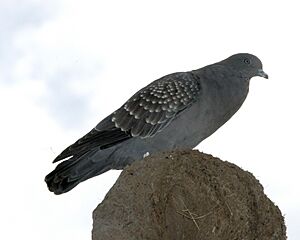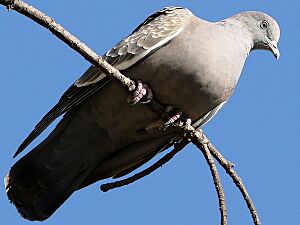Spot-winged pigeon facts for kids
Quick facts for kids Spot-winged pigeon |
|
|---|---|
 |
|
| P. m. maculosa | |
 |
|
| P. m. albipennis | |
| Conservation status | |
| Scientific classification | |
| Genus: |
Patagioenas
|
| Species: |
maculosa
|
 |
|
| Synonyms | |
|
Columba maculosa Temminck, 1813 |
|
The spot-winged pigeon (Patagioenas maculosa) is a type of bird that belongs to the Columbidae family, which includes pigeons and doves. You can find this bird in several South American countries, including Argentina, Bolivia, Brazil, Chile, Paraguay, Peru, and Uruguay.
Contents
About the Spot-Winged Pigeon
Scientists group living things into categories. This helps us understand how different animals are related. The spot-winged pigeon is part of a group of pigeons called Patagioenas.
Some scientists think the spot-winged pigeon is closely related to other pigeons like the picazuro pigeon and the scaled pigeon. They look similar in their feathers. However, other scientists disagree because their calls sound very different.
There are two main types, or subspecies, of the spot-winged pigeon:
- P. m. maculosa
- P. m. albipennis
Some experts even think P. m. albipennis should be considered its own separate species, called the white-winged pigeon.
What Do They Look Like?
The two types of spot-winged pigeons have different looks.
P. m. maculosa
This pigeon is about 32 to 33 centimeters (12.6 to 13 inches) long. It weighs around 308 to 347 grams (10.9 to 12.2 ounces).
- Adult Males: Their head, neck, and chest are usually a dull purplish-pink color. The rest of their head and belly are gray. Their upper back and wing feathers are dark brown with creamy white spots. Their wings are mostly black on top and light gray underneath. The lower back and tail are bluish-gray and dark gray.
- Adult Females: They look similar to males, but their head and neck colors are not as bright.
- Young Pigeons: They are duller in color all over, with a drab gray head and chest.
P. m. albipennis
This type is a bit larger, measuring 33 to 34 centimeters (13 to 13.4 inches) long.
- Adults: Their head, neck, lower back, and entire belly are blue-gray. They have a purplish tint, which is stronger in males. Their upper back and wing feathers are gray-brown. When their wings are folded, you can see a clear white band that stands out against the darker wing.
- Young Pigeons: Like the other type, young P. m. albipennis are duller versions of the adults.
Where Do They Live?
Both types of spot-winged pigeons live in dry or semi-dry areas with open woodlands and scrub.
P. m. maculosa Habitat
You can find P. m. maculosa in southeastern Bolivia, and then south and east through Paraguay, southern Brazil, and Uruguay, all the way to south-central Argentina. They live at elevations up to 1,000 meters (3,300 feet). They tend to avoid towns and cities.
P. m. albipennis Habitat
P. m. albipennis lives from central Peru south to western and central Bolivia, the very northwest of Argentina, and northern Chile. They also prefer dry or semi-dry open woodlands and scrub. However, they live at much higher elevations, usually between 2,000 and 4,300 meters (6,600 and 14,100 feet). Interestingly, they are often found in towns in their local areas.
Spot-Winged Pigeon Behavior
Feeding Habits
Both types of spot-winged pigeons usually eat in groups on the ground.
- P. m. maculosa mainly eats seeds, including rice and sunflower seeds. They have also been seen eating fruits and leaves.
- Scientists haven't studied what P. m. albipennis eats yet.
Reproduction and Life Cycle
- P. m. maculosa breeds all year round in Argentina, and likely in Brazil too. They build a simple, fragile nest in trees. Females usually lay one or two eggs.
- We don't know much about when P. m. albipennis breeds. However, their calls seem to increase in October, which might mean their breeding season is starting then.
Vocalization (Calls and Songs)
Pigeons use different sounds to communicate.
- P. m. maculosa's song is a rough, rhythmic sound that goes "cuuuuu uh-cuh-cuuuh..." and is repeated two or three times. Their call is a repeated "grwhoh" sound.
- P. m. albipennis's song is a gruff "rrrrrow grr-g’RRRR grr-g’RRRR grr-g’RRRR". Their call is a short "corw".
Conservation Status
The IUCN (International Union for Conservation of Nature) looks at how many animals are left in the wild. They treat P. m. maculosa and P. m. albipennis as separate species when checking their status. Both are listed as "Least Concern." This means they are not currently at risk of disappearing.
- P. m. maculosa is common and found in many places in the southern part of its range. Its population might even be growing.
- P. m. albipennis lives in more specific areas, but its population might also be increasing.


